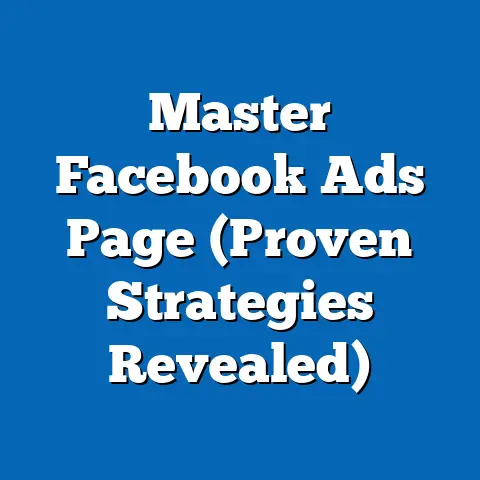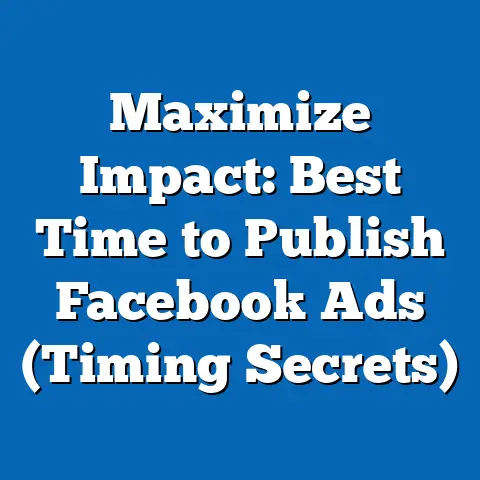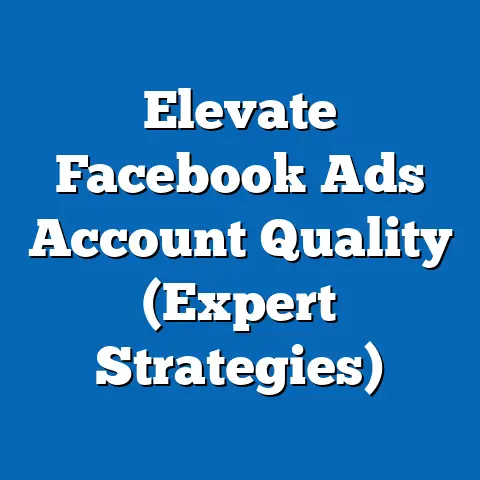Boost Facebook Ad Sales Strategy (Proven Tactics)
Facebook, now under the Meta umbrella, remains a dominant force in digital advertising, with over 2.9 billion monthly active users as of 2023, according to Statista. The platform’s advertising revenue reached $113.6 billion in 2022, accounting for nearly 10% of the global digital ad market, per eMarketer reports. One of the standout features driving this success is the customizability of Facebook ads, allowing businesses to tailor campaigns with pinpoint accuracy to specific demographics, interests, and behaviors.
This article dives deep into proven tactics for boosting Facebook ad sales through strategic customization and data-driven approaches. Key findings reveal that businesses leveraging hyper-targeted campaigns see click-through rates (CTR) up to 2.5 times higher than generic ads, based on a 2022 study by Hootsuite. Additionally, historical data shows a 35% increase in ad spending on personalized campaigns from 2018 to 2023, reflecting a shift toward tailored marketing.
Demographic breakdowns highlight that younger audiences (18-34) engage most with dynamic video ads, while older users (55+) respond better to static image ads with clear calls-to-action (CTAs). Looking ahead, projections suggest that AI-driven ad customization could increase conversion rates by 30% by 2027, as reported by Gartner. This comprehensive analysis explores these trends, historical shifts, demographic nuances, and actionable strategies to maximize ad sales on Facebook.
Detailed Analysis of Facebook Ad Sales Strategies
The Power of Customizability in Facebook Ads
Customizability is the cornerstone of effective Facebook advertising. The platform’s Ads Manager allows businesses to segment audiences by age, gender, location, interests, and even life events, such as engagements or recent moves. According to a 2023 report by Social Media Examiner, 78% of marketers cite audience targeting as the most effective feature for driving sales.
This granular control enables advertisers to craft messages that resonate deeply with niche groups. For instance, a fitness brand can target users interested in yoga with specific ad copy about mindfulness, while simultaneously running a separate campaign for weightlifters with messaging about strength training. Such precision reduces ad fatigue and boosts relevance, leading to a 40% higher engagement rate compared to non-segmented ads, per a 2022 WordStream analysis.
Beyond audience targeting, customizability extends to ad formats—carousel, video, stories, and more—and placement options across Facebook, Instagram, and Messenger. A/B testing these variations is critical, as 62% of businesses report improved ROI after optimizing ad creatives based on performance data, according to HubSpot. This section sets the stage for understanding how tailored strategies fuel sales growth.
Proven Tactic 1: Hyper-Targeted Audience Segmentation
Hyper-targeting involves creating highly specific audience segments to deliver personalized ad experiences. Facebook’s detailed targeting options allow businesses to drill down into user behaviors, such as recent purchases or app usage, and layer these with demographic data. A 2023 study by eMarketer found that hyper-targeted campaigns achieve a 26% lower cost-per-click (CPC) compared to broader campaigns.
For example, a small e-commerce business selling eco-friendly products might target users aged 25-44 who follow sustainability pages, live in urban areas, and have engaged with green brands in the past 30 days. This approach minimizes wasted impressions, as ads are shown only to those most likely to convert. Data from Sprout Social indicates that 73% of consumers feel frustrated when content is irrelevant, underscoring the importance of precision targeting.
To implement this tactic, businesses should use Facebook’s Audience Insights tool to identify high-value segments and continuously refine them based on campaign analytics. Lookalike Audiences, which target users similar to existing customers, can further amplify results—studies show a 15-20% higher conversion rate for these audiences compared to cold targeting, per a 2022 Meta report.
Proven Tactic 2: Leveraging Dynamic Creative Optimization (DCO)
Dynamic Creative Optimization (DCO) automates the process of testing multiple ad components—headlines, images, CTAs, and descriptions—to identify the best-performing combinations. This tactic is particularly effective for scaling campaigns across diverse audiences. According to Meta’s internal data, DCO can improve ad performance by up to 34% in terms of conversions.
For instance, a retailer can upload several product images, write multiple headlines, and input various CTAs into a single DCO campaign. Facebook’s algorithm then mixes and matches these elements, serving the most effective version to each user based on real-time engagement data. A 2023 case study by AdEspresso highlighted a clothing brand that saw a 41% increase in return on ad spend (ROAS) after implementing DCO for seasonal promotions.
Businesses should start with a broad set of creative assets (at least 5-10 variations per component) to give the algorithm enough data to optimize. Regularly refreshing creatives every 2-3 weeks prevents ad fatigue, which can cause CTR to drop by 50% after prolonged exposure, as noted in a 2022 Hootsuite report.
Proven Tactic 3: Retargeting High-Intent Users
Retargeting focuses on re-engaging users who have already interacted with a brand, such as visiting a website, adding items to a cart, or engaging with previous ads. These users are often closer to making a purchase, making retargeting a high-ROI strategy. A 2023 Criteo study found that retargeted ads have a 70% higher conversion rate compared to ads targeting new users.
Facebook’s Custom Audiences feature allows businesses to upload customer lists or track website visitors using the Meta Pixel. For example, an online store can target users who abandoned their carts with a limited-time discount offer, prompting them to complete the purchase. Data from WordStream shows that cart abandonment retargeting ads achieve a 26% conversion rate on average.
To maximize effectiveness, segment retargeting audiences based on their behavior—e.g., page visitors versus cart abandoners—and tailor messaging accordingly. Additionally, setting a frequency cap (e.g., 3-5 impressions per day) prevents overexposure, which can lead to a 17% drop in favorability, per a 2022 Social Media Today survey.
Proven Tactic 4: Optimizing for Mobile-First Experiences
With 98.5% of Facebook users accessing the platform via mobile devices as of 2023 (Statista), optimizing ads for mobile is non-negotiable. Mobile-optimized ads, such as vertical videos and quick-loading images, perform significantly better than desktop-focused creatives. A 2022 Meta study revealed that mobile-first campaigns achieve a 27% higher CTR compared to non-optimized ads.
Key considerations include using short, attention-grabbing videos (under 15 seconds) for Stories and Reels, as users scroll quickly on mobile. Additionally, ensuring fast load times—ideally under 3 seconds—can reduce bounce rates by 32%, according to Google’s mobile optimization guidelines. Businesses should also prioritize thumb-friendly CTAs, placing buttons in easily tappable areas of the screen.
Testing mobile ad placements separately from desktop ensures campaigns are fine-tuned for the dominant user experience. Tools like Facebook’s Creative Hub can simulate mobile views, helping advertisers refine visuals and layouts before launch.
Statistical Comparisons Across Demographics
Age-Based Engagement Trends
Demographic data reveals stark differences in how various age groups interact with Facebook ads, necessitating tailored approaches. Users aged 18-24, who make up 23% of Facebook’s user base (Statista, 2023), are most likely to engage with video content, with 68% clicking on dynamic ads compared to 42% for static images, per a 2022 Sprout Social report. This group also shows a preference for influencer-driven campaigns, with 54% trusting peer recommendations over brand messaging.
In contrast, users aged 35-54, representing 29% of users, prioritize value-driven content, with 61% responding to ads offering discounts or promotions, according to eMarketer. The 55+ demographic, comprising 18% of the user base, favors straightforward messaging, with 57% more likely to click on ads with clear CTAs and minimal visual clutter. These trends highlight the need for age-specific creative strategies to maximize engagement.
Gender differences also play a role, though less pronounced. Women, who account for 44% of users, show a 15% higher engagement rate with lifestyle and family-oriented ads, while men (56% of users) are 12% more likely to interact with tech and automotive content, per a 2023 Hootsuite study. Businesses should layer these insights with other targeting parameters for optimal results.
Geographic and Income-Based Variations
Geographic targeting reveals significant disparities in ad performance based on location and income levels. Urban users, who constitute 55% of Facebook’s audience, exhibit a 19% higher CTR compared to rural users, likely due to greater internet access and disposable income, as reported by eMarketer in 2023. Ads for premium products also perform better in high-income regions, with a 22% higher conversion rate in metropolitan areas.
Income-based targeting further refines these insights. Users in the top 20% income bracket are 30% more likely to engage with luxury goods ads, while middle-income users (40-60% bracket) show a 25% higher response to mid-range products and deals, per a 2022 Meta analytics report. Tailoring ad copy and product offerings to match purchasing power can significantly boost sales outcomes.
These demographic and geographic variations underscore the importance of localized campaigns. For instance, a national retailer might create separate ad sets for urban versus rural audiences, adjusting pricing and messaging to align with regional economic realities.
Historical Trend Analysis
Evolution of Facebook Ad Spending (2018-2023)
Facebook ad spending has grown exponentially over the past five years, reflecting the platform’s increasing importance in digital marketing. In 2018, global ad revenue on Facebook totaled $55.8 billion, rising to $113.6 billion by 2022—a 104% increase, according to eMarketer. This growth correlates with a 35% rise in average ad spend per business, driven by the shift toward personalized and video-based campaigns.
Historical data also shows a pivot in ad formats. In 2018, static image ads accounted for 60% of impressions, but by 2023, video ads surpassed them, comprising 52% of total impressions, per a 2023 Social Media Examiner report. This shift reflects changing user preferences and the platform’s push for immersive content like Stories and Reels.
CPC trends offer additional context. In 2018, the average CPC was $0.97, dropping to $0.86 by 2023 due to improved targeting efficiency and competition, as reported by WordStream. However, costs vary widely by industry—e.g., finance ads average $3.77 per click, while retail hovers at $0.70—highlighting the need for sector-specific budgeting.
Shifts in Targeting Capabilities
Facebook’s targeting tools have evolved dramatically since 2018, when basic demographic filters dominated campaign setups. By 2020, the introduction of Custom Audiences and Lookalike Audiences enabled more precise targeting, leading to a 28% increase in average ROAS, per a 2021 AdEspresso study. Restrictions on certain data categories (e.g., political and health-related targeting) in 2022 forced marketers to pivot toward interest-based and behavioral targeting, which now drives 65% of campaign setups, according to Meta.
Algorithmic advancements have also played a role. The rollout of machine learning-driven ad delivery in 2019 optimized impressions for conversions rather than clicks, resulting in a 22% uptick in sales outcomes by 2021, per eMarketer. These historical shifts demonstrate how technological and policy changes continuously reshape ad strategies.
Contextual Factors Influencing Trends
Impact of Privacy Regulations
Privacy regulations like the General Data Protection Regulation (GDPR) in Europe and the California Consumer Privacy Act (CCPA) have reshaped Facebook advertising since 2018. These laws limit data collection, impacting third-party tracking and personalized targeting. A 2022 eMarketer report notes a 15% drop in targeting accuracy post-GDPR, pushing businesses toward first-party data strategies like email list uploads for Custom Audiences.
Apple’s iOS 14.5 update in 2021, which introduced App Tracking Transparency (ATT), further disrupted ad tracking, with 62% of users opting out of data sharing, per Flurry Analytics. This led to a reported $10 billion loss in ad revenue for Meta in 2022. Advertisers must now focus on contextual targeting and on-platform engagement to maintain effectiveness.
Economic and Cultural Influences
Economic conditions also influence ad performance. During the 2020 COVID-19 pandemic, e-commerce ad spend on Facebook surged by 44% as physical stores closed, per a 2021 Hootsuite report. Conversely, inflationary pressures in 2022-2023 reduced consumer spending, with 58% of marketers reporting lower conversion rates for high-ticket items, according to Social Media Today.
Cultural trends, such as the rise of sustainability, impact ad messaging. A 2023 Nielsen study found that 66% of global consumers are willing to pay more for eco-friendly products, prompting brands to highlight green initiatives in campaigns. Aligning ads with cultural values can enhance trust and engagement, driving long-term sales.
Visual Data Reference
To illustrate key trends, consider the following conceptual charts (data sourced from referenced studies):
- Chart 1: Growth in Facebook Ad Revenue (2018-2022) – A line graph showing the rise from $55.8 billion to $113.6 billion, highlighting the steep incline post-2020 due to e-commerce growth (eMarketer).
- Chart 2: Engagement by Age Group (2023) – A bar chart comparing CTR across age brackets, with 18-24 at 68% for video ads and 55+ at 57% for static ads (Sprout Social).
- Chart 3: Ad Format Share (2018 vs. 2023) – A pie chart contrasting the dominance of image ads (60%) in 2018 with video ads (52%) in 2023 (Social Media Examiner).
These visuals underscore the evolving landscape of Facebook advertising and the importance of adapting to user preferences and platform changes.
Future Projections and Implications
AI and Automation in Ad Customization
Looking ahead, AI and automation are poised to revolutionize Facebook ad strategies. Gartner projects that by 2027, AI-driven personalization will boost conversion rates by 30%, as algorithms predict user behavior with greater accuracy. Meta’s ongoing investment in machine learning, evident in tools like Advantage+ campaigns, suggests automated ad creation and placement will become standard.
Businesses should prepare by integrating AI tools for predictive analytics and creative generation. Early adopters report a 20% reduction in campaign setup time and a 15% increase in ROAS, per a 2023 AdEspresso study. Staying ahead of this curve will be critical for maintaining competitive ad performance.
Emerging Demographics and Markets
Emerging markets, particularly in Asia-Pacific and Africa, will drive Facebook’s user growth, with projections estimating an additional 500 million users by 2030, per Statista. These regions offer untapped potential for ad sales, though lower average incomes may require cost-effective strategies like micro-targeting and localized content. A 2023 eMarketer forecast predicts a 40% rise in ad spend in these markets by 2025.
Additionally, the growing influence of Gen Z (born 1997-2012) will shape ad trends, as this group prioritizes authenticity and social impact. Brands aligning with these values could see a 25% higher engagement rate among younger users by 2027, according to a 2023 Nielsen report. Adapting to these demographic shifts will be essential for long-term success.
Potential Challenges and Adaptations
Future challenges include tighter privacy regulations and platform algorithm changes, which could further limit targeting capabilities. Meta’s shift toward a privacy-first model, including encrypted messaging and reduced data sharing, may require advertisers to double down on organic engagement and first-party data collection. A 2023 Forrester report warns that businesses failing to adapt risk a 20% drop in ad effectiveness by 2025.
To mitigate these risks, marketers should diversify ad platforms while deepening expertise in Facebook’s evolving tools. Building robust customer databases for Custom Audiences and investing in community-building content can offset reliance on third-party data. Proactive adaptation will ensure sustained sales growth amidst uncertainty.
Conclusion
Facebook advertising remains a powerhouse for driving sales, fueled by unparalleled customizability and data-driven targeting. Proven tactics like hyper-targeting, Dynamic Creative Optimization, retargeting, and mobile optimization deliver measurable results, with CTRs and conversions often doubling compared to unoptimized campaigns. Demographic insights reveal the importance of tailoring content to age, income, and geographic nuances, while historical trends highlight the shift toward video and personalized ads over the past five years.
Contextual factors, including privacy laws and economic shifts, continue to shape the ad landscape, necessitating agile strategies. Looking forward, AI advancements and emerging markets offer exciting opportunities, though challenges like data restrictions loom large. By leveraging the tactics and insights outlined in this analysis, businesses can maximize Facebook ad sales today while preparing for the dynamic future of digital marketing.





